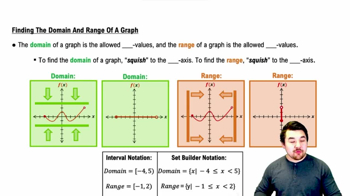Table of contents
- 0. Functions7h 52m
- Introduction to Functions16m
- Piecewise Functions10m
- Properties of Functions9m
- Common Functions1h 8m
- Transformations5m
- Combining Functions27m
- Exponent rules32m
- Exponential Functions28m
- Logarithmic Functions24m
- Properties of Logarithms34m
- Exponential & Logarithmic Equations35m
- Introduction to Trigonometric Functions38m
- Graphs of Trigonometric Functions44m
- Trigonometric Identities47m
- Inverse Trigonometric Functions48m
- 1. Limits and Continuity2h 2m
- 2. Intro to Derivatives1h 33m
- 3. Techniques of Differentiation3h 18m
- 4. Applications of Derivatives2h 38m
- 5. Graphical Applications of Derivatives6h 2m
- 6. Derivatives of Inverse, Exponential, & Logarithmic Functions2h 37m
- 7. Antiderivatives & Indefinite Integrals1h 26m
- 8. Definite Integrals4h 44m
- 9. Graphical Applications of Integrals2h 27m
- 10. Physics Applications of Integrals 2h 22m
0. Functions
Introduction to Functions
Problem 41a
Textbook Question
Velocity from position The graph of represents the position of an object moving along a line at time . <IMAGE>
a. Assume the velocity of the object is 0 when . For what other values of t is the velocity of the object zero?
 Verified step by step guidance
Verified step by step guidance1
Step 1: Understand that the velocity of an object is the derivative of its position function with respect to time, i.e., v(t) = f'(t).
Step 2: Since the velocity is zero at t = 0, we need to find other values of t where the derivative f'(t) = 0.
Step 3: Analyze the graph of s = f(t) to identify points where the tangent to the curve is horizontal, as these correspond to points where f'(t) = 0.
Step 4: Look for critical points on the graph where the slope of the tangent line is zero, indicating potential values of t where the velocity is zero.
Step 5: Verify these points by considering the behavior of the graph around these critical points to ensure they are indeed points where the velocity is zero.
 Verified video answer for a similar problem:
Verified video answer for a similar problem:This video solution was recommended by our tutors as helpful for the problem above
Video duration:
2mPlay a video:
Was this helpful?
Key Concepts
Here are the essential concepts you must grasp in order to answer the question correctly.
Position Function
The position function, denoted as s = f(t), describes the location of an object along a line at any given time t. Understanding this function is crucial because it provides the basis for analyzing the object's motion. The graph of this function visually represents how the position changes over time, allowing us to infer other properties like velocity and acceleration.
Recommended video:

Relations and Functions
Velocity
Velocity is defined as the rate of change of position with respect to time, mathematically expressed as v(t) = f'(t), where f'(t) is the derivative of the position function. It indicates how fast and in what direction the object is moving. When the velocity is zero, it signifies that the object is momentarily at rest, which is essential for determining points of interest in motion analysis.
Recommended video:

Derivatives Applied To Velocity
Critical Points
Critical points occur where the derivative of a function is zero or undefined, indicating potential local maxima, minima, or points of inflection. In the context of velocity, finding critical points helps identify when the object's velocity is zero, which corresponds to moments when the object stops or changes direction. Analyzing these points is vital for understanding the overall motion of the object.
Recommended video:

Critical Points

 1:36m
1:36mWatch next
Master Introduction to Calculus Channel with a bite sized video explanation from Callie
Start learning




